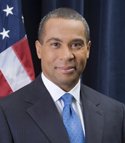BOSTON, Mass. /Massachusetts Newswire/ -– Governor Deval Patrick today released a new Fiscal Year 2010 budget proposal following a dramatic and unanticipated revenue decline between January and April. The revised version of an already austere budget proposal reflects a revenue loss of $1.5 billion in the three months since the Governor filed his original recommendations, and is intended to serve as a blueprint for lawmakers currently negotiating the differences in their own budgets.
 While the $26.9 billion budget includes many difficult cuts, Governor Patrick’s proposal maintains his commitment to core services including education, public safety and health care.
While the $26.9 billion budget includes many difficult cuts, Governor Patrick’s proposal maintains his commitment to core services including education, public safety and health care.
“The Commonwealth, like every state in the nation, has experienced unprecedented fiscal challenges caused by the global economic crisis,” said Governor Patrick. “This budget reflects the fact that revenues have continued to rapidly decline since we filed House 1 in January, forcing us to make another round of painful cuts. I remain committed to protecting key programs like education and health care, and will continue to responsibly manage the state’s finances so that Massachusetts emerges from this downturn stronger than before.”
The updated budget continues to hold Chapter 70 education aid harmless at the original FY09 level of $3.9 billion. As the Governor pledged earlier this year, the revised budget also includes an additional $168 million in federal stimulus funds to ensure every school district remains at foundation level. The Governor also maintained $4.5 million for Shannon Grants, $8 million for summer jobs programs for at risk-youth and continued his commitment to health care by maintaining eligibility standards and access.
The Governor’s revised budget is 4.5 percent lower than the FY09 budget he signed in July of last year. Nearly half of the solutions the Governor has used to close the $5.1 billion gap for FY10 are cuts, spending reductions and savings. In addition, his proposal relies on federal stimulus aid and new revenues previously proposed in his original budget.
“As we have done throughout the current fiscal year, we have taken a multi-pronged approach to closing the significant gap we face for FY10,” said Administration and Finance Secretary Leslie A. Kirwan. “The decisions in this budget will impact many residents, organizations and local governments in the Commonwealth. It is our hope that the decisions we made in this budget, while painful for many, will set the Commonwealth on a course for economic growth as we emerge from this unprecedented downturn.”
The Governor’s budget does not include an increase in the sales tax, as he continues to seek meaningful pension, ethics and transportation reform before asking residents to pay more in broad-based taxes.
While the Governor’s revised budget continues to recommend many of the same proposals that were included in his original budget, it was necessary for him to make further reductions in spending to close the $1.6 billion gap. His new proposal contains an additional $794 million in spending reductions, including the elimination of Quinn Bill benefits for municipal police officers ($42 million), a reduction in non–education local aid ($80 million) and a $164 million reduction in MassHealth spending, primarily through the elimination of adult dental benefits.
In light of the revenue decline that has occurred since January, the Governor has reduced the Administration’s use of the state’s Rainy Day Fund for FY10 in order to preserve more of the fund for future budgets. The revised budget includes $225 million in stabilization funds instead of the $489 originally proposed. This will leave more than half a billion dollars in the fund for FY11 as the Commonwealth cycles out of the economic downturn. The revised budget also includes $1.489 billion in federal recovery aid that will continue to support health care and education programs.
Other Key Differences between the Governor’s FY10 budgets
State employee health insurance– The Governor’s revised proposal again includes a plan to reform the state employee health care system, moving from a system based on date of hire to a system based on salary levels and affordability. The revised budget calls for tiering as originally proposed, but increases the percentage of employee contribution by 5 percent. Employees earning less than $35,000 would contribute 20 percent; employees earning $35,000 to $50,000 would contribute 25 percent; and employees earning more than $50,000 would contribute 30 percent. These changes will generate roughly $86 million in savings, $26 million more than originally estimated.
Other state personnel impacts– The revised budget also includes $65 million in savings to be achieved through a combination of further personnel reductions and/or union accommodations. The Administration is also increasing health care contributions for future retirees.
Universal Immunization– Following the lead of many other states, the Governor’s revised budget saves the Commonwealth $50 million by requiring insurers to cover the costs of universal immunizations.





